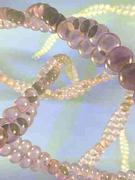|
|
|
Current News |
|
Chemistry A to Z |
|
About Internetchemistry |
Are we built of glass? |
|
In 2001, their extensive examinations of human lung cells led Ben Fabry and Jeffrey Fredberg, two scientists at the Harvard School of Public Health, to ask this provocative question. They were, of course, not literally suggesting that humans are built out of window glass. Instead they wanted to draw attention to a perplexing similarity between the mechanical behavior of individual living cells and that of a large class of inanimate materials comprising foams, emulsions, slurries and pastes. All these materials exhibit apparent power-law rheology power-law increase in strain over time following application of a step stress) with very small power-law exponents, the fingerprint of ``soft glassy rheology''. The ubiquity of power-law rheology and the corresponding broad, scale-free spectrum of internal relaxation times in soft condensed matter had been interpreted in terms of rough free energy landscapes by the theoretical physicist Peter Sollich and his coworkers a few years earlier. Viewed in this light, the observations of Fabry and Fredberg suggested that many organisms live close to a glass transition - a notion referring to an unusual state change of matter, where the dynamics slows down dramatically without any noticeable structural change. Could this property help cells to fulfill their multiple mechanical tasks in scaffolding, force generation, division and proliferation within a soft tissue, where they experience a wide range of dynamical stimuli - from the sudden jerk of a muscle to the gradual growth of a bone? Despite substantial research effort, the physical or biological origin of the apparently very robust and universal glassy dynamics of cells has remained obscure. |
|
As reported in the forthcoming issue of the Proceedings of the National Academy of Sciences USA (PNAS), a promising candidate for a universal mechanism underlying the intriguing observations of soft glassy rheology in living cells has now been discovered. Combining diverse physical measurement techniques and theory, three German biophysics groups located in J�lich, Leipzig and Munich have demonstrated that entangled solutions of pure filamentous actin undergo a dramatic slowdown upon slight changes of composition or ambient conditions. Actin is the dominant polymeric constituent of the cytoskeleton (the "bones and muscles" in the interior of a cell) and therefore forms a promising target in the search for a unified physical theory of cell mechanics. Using highprecision dynamic light scattering, the group at the J�lich Research Center headed by Rudolf Merkel was able to detect a curious timestretching in the Brownian dynamics of actin: upon lowering the temperature only slightly, the spectrum of relaxation rates of the actin filaments spread out enormously. This property is also a key element of a new theoretical model of cell mechanics, called the glassy wormlike chain. This theory not only fits the data over many decades in time, it also explains the complicated nonlinear response to an applied stress or strain that was measured by the group of Andreas Bausch at the Technical University Munich. Unlike cells and tissues, actin filament solutions flow like a liquid over long times. However, if stretched sufficiently rapidly, they reveal a broad linear response followed by pronounced stiffening as the stress is increased. This property is strongly reminiscent of known results for crosslinked actin networks, living cells, and tissues (which you can easily confirm by pulling on your cheeks). For actin, the degree of stiffening increases sharply with decreasing sample temperature, in accord with the common experience that your body feels stiff when it is cold. Remarkably, as the research team reports, not only temperature but many different physiological parameters can trigger exactly the same stiffening transition. Further, what first appear to be distinct mechanical signatures in the response to stress turn out to be equivalent after rescaling the deformation speed (or time). If this "rheological redundancy'' also applied to living cells, it would mean they could choose from a vast arsenal of different molecular mechanisms to adjust their mechanical properties to the same unique overall performance. A related intriguing question concerns the role played by cell mechanics in regulating the internal biological clock, which endows living organisms with an emergent concept of time - or, as Klaus Kroy from the Institute of Theoretical Physics in Leipzig puts it, "whether the physical phenomenon of a glass transition could be the clue to understanding the coherent slowdown of the physiological functions of cold-blooded or hibernating animals or how bacteria manage to survive millions of years in permafrost". |
|
|
|

